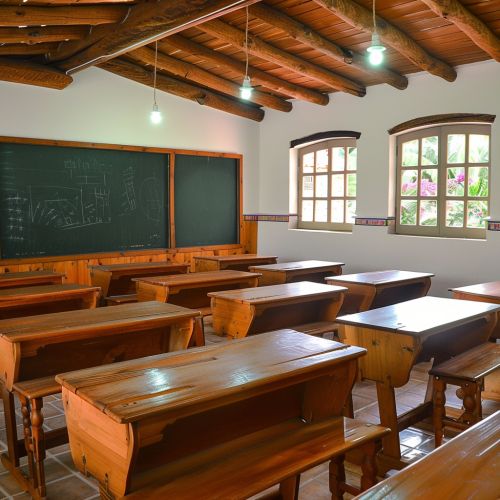Cheder: Difference between revisions
(Created page with "== Overview == A '''Cheder''' is a traditional elementary school teaching the basics of Judaism and the Hebrew language. The term is Hebrew for "room", and originally referred to the one-room schoolhouses that were common in Jewish communities until the late 18th century. The Cheder played a pivotal role in the education of Jewish children, providing them with the foundational knowledge necessary to participate fully in Jewish religious and communal life. Judaism|Jewis...") |
No edit summary |
||
| Line 5: | Line 5: | ||
The Cheder system dates back to the Talmudic era, with the earliest references appearing in the [[Talmud|Talmudic]] literature of the 2nd century CE. The Talmud mandates that fathers teach their sons Torah, and the Cheder was the institution that facilitated this commandment. The Cheder system was prevalent throughout Europe, North Africa, and the Middle East, wherever Jewish communities were found. | The Cheder system dates back to the Talmudic era, with the earliest references appearing in the [[Talmud|Talmudic]] literature of the 2nd century CE. The Talmud mandates that fathers teach their sons Torah, and the Cheder was the institution that facilitated this commandment. The Cheder system was prevalent throughout Europe, North Africa, and the Middle East, wherever Jewish communities were found. | ||
[[Image:Detail-77865.jpg|thumb|center|A traditional Cheder classroom with wooden desks and a blackboard.]] | |||
In the Middle Ages, the Cheder was the primary means of education for Jewish boys. Girls were usually educated at home by their mothers, although there were exceptions. The curriculum focused on the study of the [[Torah|Torah]] and the [[Talmud|Talmud]], as well as prayers and ethical teachings. The teaching methods were often rote memorization and repetition, with a strong emphasis on discipline. | In the Middle Ages, the Cheder was the primary means of education for Jewish boys. Girls were usually educated at home by their mothers, although there were exceptions. The curriculum focused on the study of the [[Torah|Torah]] and the [[Talmud|Talmud]], as well as prayers and ethical teachings. The teaching methods were often rote memorization and repetition, with a strong emphasis on discipline. | ||
Revision as of 03:42, 8 May 2024
Overview
A Cheder is a traditional elementary school teaching the basics of Judaism and the Hebrew language. The term is Hebrew for "room", and originally referred to the one-room schoolhouses that were common in Jewish communities until the late 18th century. The Cheder played a pivotal role in the education of Jewish children, providing them with the foundational knowledge necessary to participate fully in Jewish religious and communal life. Jewish law mandates that a city must first establish a Cheder before building a synagogue, emphasizing the importance of education in Jewish culture.
History
The Cheder system dates back to the Talmudic era, with the earliest references appearing in the Talmudic literature of the 2nd century CE. The Talmud mandates that fathers teach their sons Torah, and the Cheder was the institution that facilitated this commandment. The Cheder system was prevalent throughout Europe, North Africa, and the Middle East, wherever Jewish communities were found.

In the Middle Ages, the Cheder was the primary means of education for Jewish boys. Girls were usually educated at home by their mothers, although there were exceptions. The curriculum focused on the study of the Torah and the Talmud, as well as prayers and ethical teachings. The teaching methods were often rote memorization and repetition, with a strong emphasis on discipline.
The Cheder system underwent significant changes in the 19th and 20th centuries. The spread of the Haskalah (Jewish Enlightenment) movement led to calls for modernization and secularization of Jewish education. This led to the establishment of modern Jewish day schools and yeshivas, which incorporated secular subjects into the curriculum along with traditional Jewish studies.
Structure and Curriculum
The Cheder typically consists of one teacher and a small group of students, ranging in age from six to thirteen. The students are usually divided into groups according to their level of knowledge and ability. The teacher, known as a Melamed, is often a learned member of the community with a deep understanding of Jewish law and tradition.
The curriculum in a Cheder is heavily focused on religious studies. The primary text studied is the Chumash (the Five Books of Moses), along with Rashi's commentary. Students also learn to read and write in Hebrew, and study Jewish laws and customs. In some Cheders, particularly those associated with the Hasidic movement, the study of Kabbalah and Hasidic philosophy is also included in the curriculum.
In addition to religious studies, some Cheders also teach secular subjects such as mathematics, science, and language arts. However, the emphasis is always on Jewish studies, and secular subjects are often taught from a Jewish perspective.
Role in Jewish Education
The Cheder plays a crucial role in Jewish education, particularly in Orthodox and Hasidic communities. It provides children with a strong foundation in Jewish law and tradition, and instills in them a love for Torah study. The Cheder also plays a social role, serving as a place where Jewish children can interact with their peers and form a strong Jewish identity.
Despite criticisms of the Cheder system, particularly its emphasis on rote learning and lack of focus on critical thinking, it remains a vital institution in many Jewish communities. Efforts have been made in recent years to modernize the Cheder system and incorporate more progressive teaching methods, while still maintaining its traditional focus on Torah study.
